A metal carport can be a great way to shelter your belongings or even add additional space for entertainment, particularly when you don’t have space inside your home or business. While you want your property and or guests to be protected from inclement weather or provide shade, you also want to make sure that they remain safe
So, is a metal carport going to be a safe option? As a general rule yes, it can be. However, safety will depend on a number of variables to include: Safety from storms and inclement weather, shielding vehicles, and equipment from the sun, safety from fire and pests. Perhaps you need protection and safety from break-ins or intrusions. Other components can be structural integrity and anchoring. Let’s look closer.
As you can imagine, trying to consider safety from all angles and variables can often be difficult, particularly if the manufacturer or dealer doesn’t give you clear advice. Let’s take a closer look at this area to find out how you can make sure your metal carport is safe.
Safety From Fire
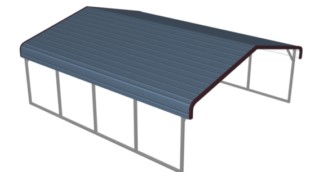
When it comes to our main competitor, wood buildings, every one of them suffers from excessive risks. The main one being fire. Nothing is completely fireproof enough, as heat will ultimately burn anything. Metal is no exception. Though, metal will hold up far better against the elements of fire than wood. If a small fire takes place due to an electrical failure, or something similar, your metal carport will have a much greater chance of keeping your property safe with the use of a fire extinguisher or a conveniently placed water hose. With a wood building conversely, a small fire can grow to be a full-blown inferno in a matter of seconds, depending on how dry and old the wood might be.
Shelter From Storms and Inclement Weather
There are other risks to consider. Snow loads for example are of high priority in certain areas of the country. The build up can sneak up on you, and before you know it your storage building is compromised and whatever property you had within it, is potentially destroyed. Carports on the other hand can be certified, and they’re typically built to your counties codes and loadings to just about whatever specifications you require
Are Metal Buildings Safe From Lightning?
Having a metal roof may have you concerned but a metal roof will not increase your building’s chances of being struck by lightning. It’s a scientific fact that lightning is not actually attracted to specific objects, surfaces, or types of material. Lightning can strike anything and occurs on too large of a scale to be influenced by distant objects on the ground, yes that includes metal.
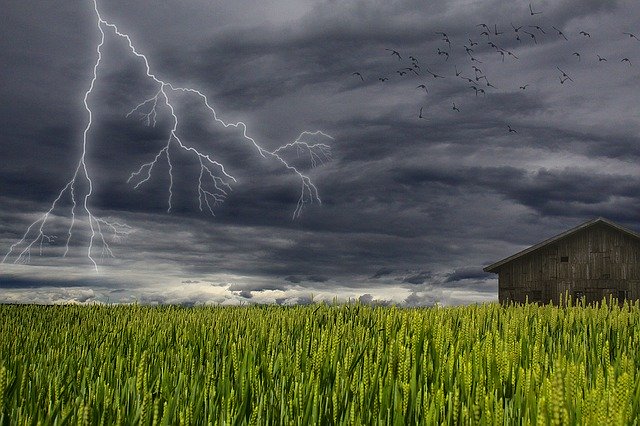
Stress over lightning is a valid concern for any property owner, but knowing the facts makes a major difference in ensuring proper preparation. So, instead of worrying about lightning having it in for your sturdy metal roof, know that the proximity of a storm is more of a determining factor than anything else. And that there is currently no known material that will decrease the likelihood of a strike.
Metal is not a lightning magnet. However, it does have the capacity to decrease the destructive impact, should lightning strike your metal carport or garage.
The best thing you can do for your own personal safety during a thunderstorm is to head indoors.
Can Metal Carports Withstand Hurricanes?
This is a question you should consider if you live somewhere that’s prone to seasonal hurricanes, straight line wind storms, and other destructive wind forces. If you ignore the possibility of the damage that can be done not only to metal building or carport, then consider the items you have stored inside them. A building designed by a licensed engineers to meet specific wind loads in your area will be your best bet.
Hurricane Wind Scale
Hurricanes are classified (1 through 5) by their sustained wind speeds, using the “Saffir-Simpson Hurricane Wind Scale“, which assesses the potential risk of property damage. Hurricanes that reach a category 3 status and higher are considered major hurricanes due to the risk of significant property damage and loss of life. The sustained wind rate for a category 3 is between 111 and 129 mph, category, 4 between 130 and 156 mph and category 5 between 157 and higher mph. One of the greatest advantages of certified metal buildings is that they are built to last. Certified metal RV carport covers are designed to withstand the most severe weather conditions. When category 3, 4 and 5 hurricanes hit your property, the best thing you can do is to have your metal building built to meet the highest wind ratings possible.
Can Metal Carports Withstand Tornados
They won’t stand up to sections of a home hitting them at hi-speed. I know of no structure that will remain undamaged after being hit with flying debris like bricks and 2×4’s, flying around as a tornado can produce.
Be Sure To Get Correct Wind Rating
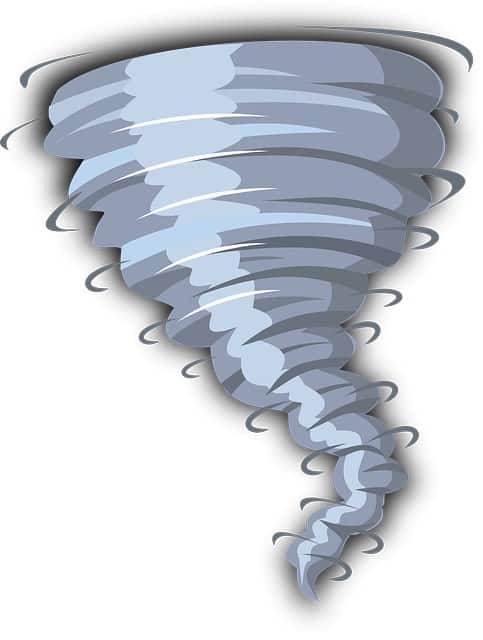
How can I be sure a metal building is built to certain wind ratings?
Ask the metal carport dealer you’re considering for the engineer drawings that are stamped by the engineer licensed in the state the garage is being built in. A reputable dealer will be happy to provide these documents for you. If not, move on.
Why Metal Buildings Stand Up To Bad weather
There are more reassuring facts about why a metal and steel building offers you such a high level of safety from severe weather.
Steel has extremely high ductility. It can absorb more energy than any other type of building material. It’s your friend in the fight against bad weather.
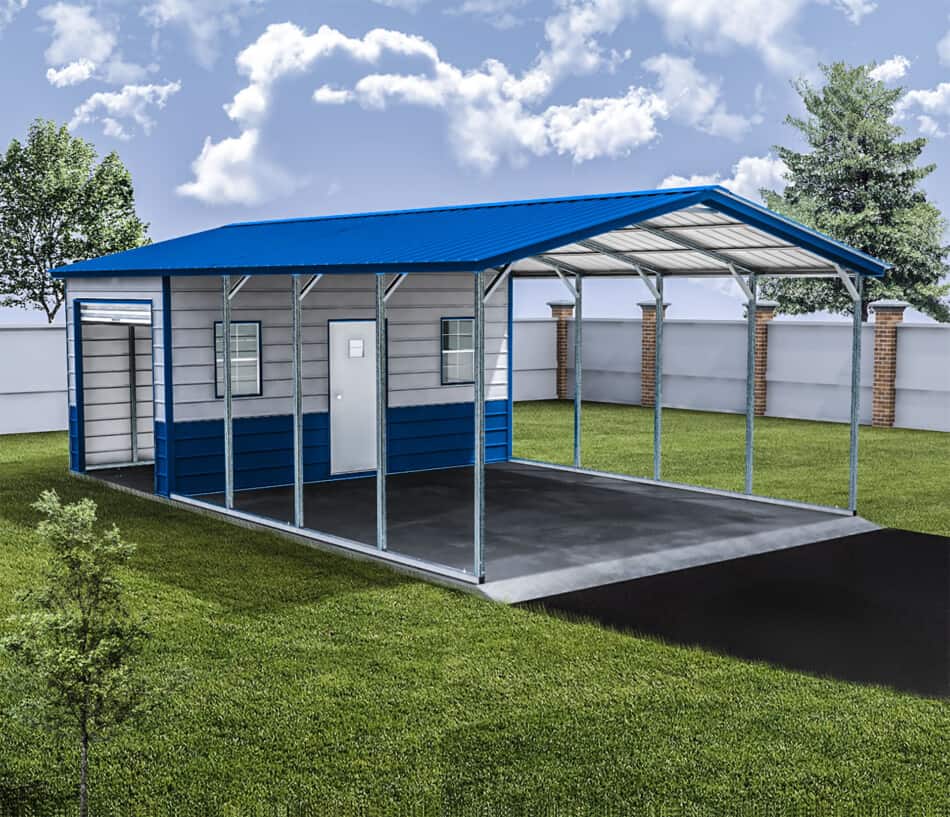
Strength-to-weight ratio. It may seem counterintuitive, but compared to what it weighs, there’s no stronger construction material than steel. A structure with the same level of strength made of wood would weigh considerably more.
How Much Weight Can a Metal Carport Hold?
Be aware, not all carports are the same! When you decide to add a carport to your home or business, make sure you understand what you need. A sturdy metal carport can typically withstand as much as 40 pounds of snow per square foot. However, some carports do a better job of allowing rain, snow, and debris to slide off easier than others.
Certified Carports
What sets certified metal carport covers apart from an uncertified metal buildings?
Non-certified metal carports haven’t earned an engineering rating for snow and wind load. Certified carports are designed by professional engineers to stand up to specific snow and wind loads in a given area. Certified carport covers may be built with additional structural tubing and include superior secure anchoring systems with extra bracing, in addition to tighter screw pattern spacing.
Be aware, not all carports are the same! When you decide to add a carport to your home or business, make sure you understand what you need. A sturdy metal carport can typically withstand as much as 40 pounds of snow per square foot. However, some carports do a better job of allowing rain, snow, and debris to slide off easier than others.

If the area you live in doesn’t require certification but is at risk of high winds or heavy snow, you’re better off buying a certified metal carport. The peace of mind you’ll experience by owning a certified garage or carport that’s built to withstand the worst that Mother Nature throws at it is a fantastic feeling. While you’ll pay a little more for a certified metal carport/garage, you’ll also benefit from the excellent value, a superior product, and outstanding performance.
Regular Roof Carport
A regular carport has rounded edges it holds up well to mild wind, rain, and sun to keep your items safe underneath. Rainwater travels down across the roof panels to keep items dry underneath.
If you live in a harsh weather climate with heavy rain, intense winds, or significant snowfall, a regular roof carport might not be the best option. You’ll need a sturdier roof to withstand severe weather. The design of a regular roof isn’t ideal for heavy rainfall or to hold the weight of snow piled on top. If your carport is longer than 31 feet, the regular roof might not be your best option.
The A-Frame Roof
Also known as the boxed-eave roof. An A-frame roof functions much like a regular roof when it comes to directing rainfall across roofing panels and over the sides of the carport. Like the regular roof style, if your carport is longer than 31 feet, an A-frame roof might not be your best option. There’s a risk of leaks at the seams for a boxed-eave roof longer than 31 feet.
Your A-frame carport will also hold up best if you live in a mild climate. The severe roof angles might not hold up to strong winds. But before you give up on a carport, if you deal with severe weather, there’s one more roofing style to consider.

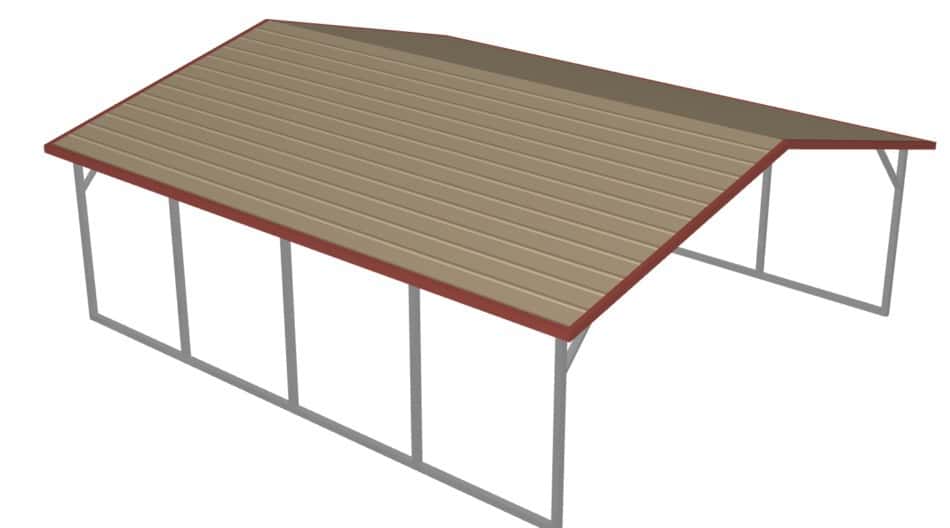
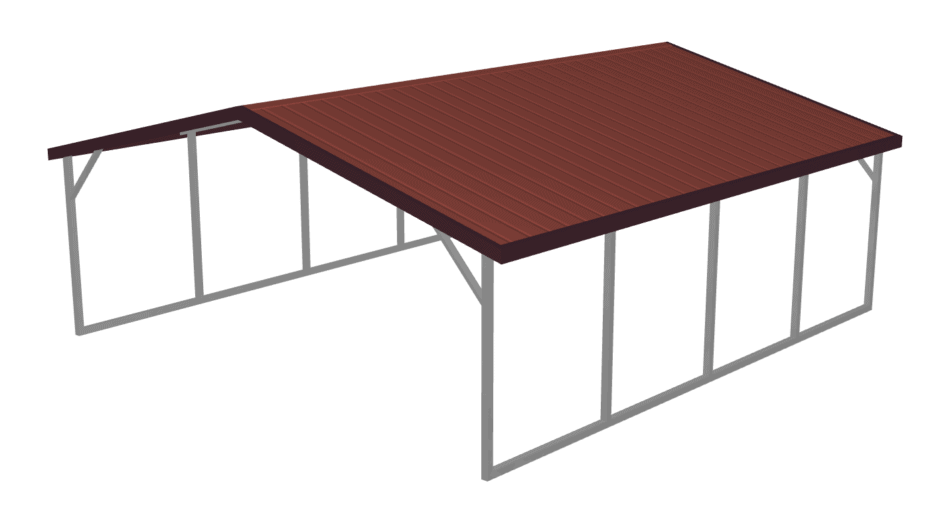
Vertical Roof Carport
With the ability to deal with more severe weather and last for many years, the vertical roof style is the strongest option of the three carport roofing styles.
Its strength comes from the vertical panels that start at the peak of your carport and end at the eaves. This design is the most durable carport roof when it comes to handling high winds, heavy rainfall, or piling snow. Your vertical roof carport is also less likely to rust compared to a regular or A-frame roof.
If your carport needs to be longer than 31 feet, choose a vertical roof. It’s less likely to leak around the seams due to the vertical roofing panels, no matter the length of your carport design.
The Durable Safety and Protection of a Steel Carport
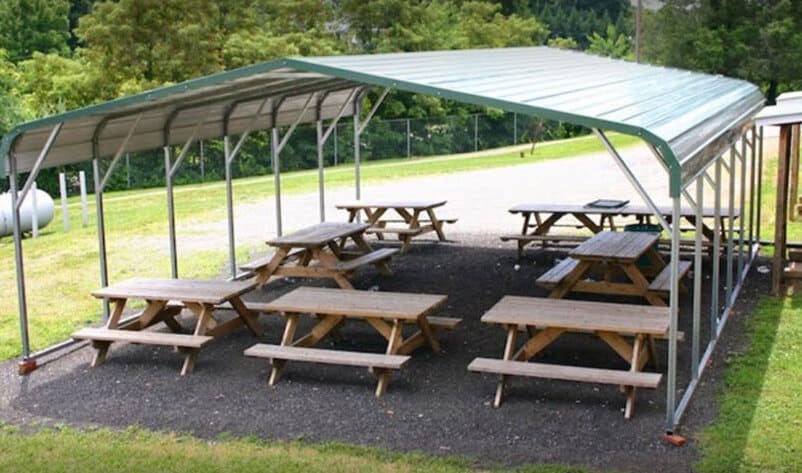
- Properly designed and constructed steel carports provide long-term durability.
- Scientific field exposure tests on steel structures built to industry-standard practices demonstrate excellent service life.
- Building codes and industry standards require that steel structures be designed to tolerate corrosion or be protected against corrosion where corrosion may impair strength or serviceability.
- Barrier coatings (such as paint) are readily available to coat the steel surface and isolate it from water and oxygen. Without water and oxygen, the steel cannot corrode.
- When further protection is needed, zinc coatings (such as galvanized tubing) are available to provide sacrificial protection as well as barrier protection. When the base metal of zinc-coated steel is exposed, such as at a cut or scratch, the steel is cathodically protected by the sacrificial corrosion of the zinc coating adjacent to the steel.
- For sheet steel, a variety of hot-dip galvanized coatings applied by the steel mill and/or paint coatings applied by a coil coating line are economical and readily available. These coatings are applied to the sheet steel prior to the coil being shipped to the manufacturer for roll forming of the finished product.
- Zinc-coated steel, which is standard for cold-formed steel framing, will last far beyond the life of a building when properly installed and insulated, and is especially appropriate in the high-demand structural configurations of mid-rise construction.
Can You Walk on a Metal Carport?
Can you walk on a metal roof without damaging it, the answer is: Yes, you can! To avoid causing any damage to a metal roof, you’ll need to proceed with caution. The roof will be fine, as long as you follow some simple rules:
- Wear soft-soled clean shoes
- Don’t drop your heavy tools on the roof
- Learn to walk in the right spots
- Walk along the framing
If you’re a homeowner and you have to walk on your metal roof for different reasons like to clean, fix something, or to wash some windows, how can you do it safely and without causing any damage to the roof?

Well, first of all, if you are inexperienced you should not get up on the roof. It is recommended to call a professional and stay off any roofs for safety reasons. But if you really need to go up on a metal roof, please, consider the three rules before getting up on a metal roof.
How Do You Secure a Metal Carport to the Ground?
Not all carports are the same! When you decide to add a carport to your home or business, make sure you understand what you need. Carports need to be sturdy enough to withstand the elements while protecting cars or other equipment. From color to size, it’s critical to customize your carport to your needs—and that includes anchors.
Asphalt Anchor
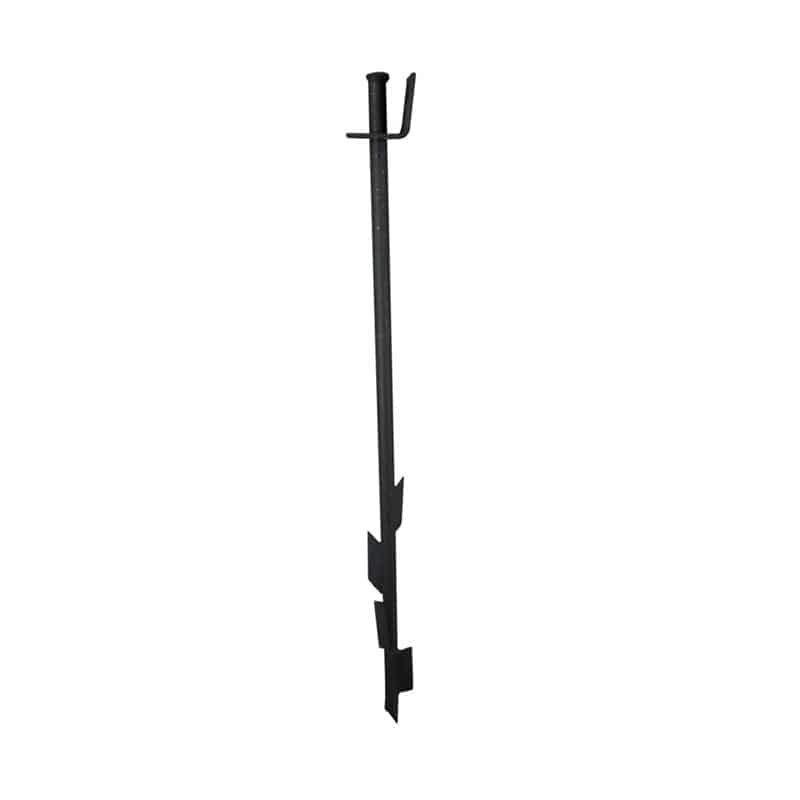
These anchors are used in asphalt installations only and may or may not be included with the building. They have four fins which, when driven into the ground, will hold the anchor in like hooks, keeping the building secure during high wind situation
Concrete Anchor
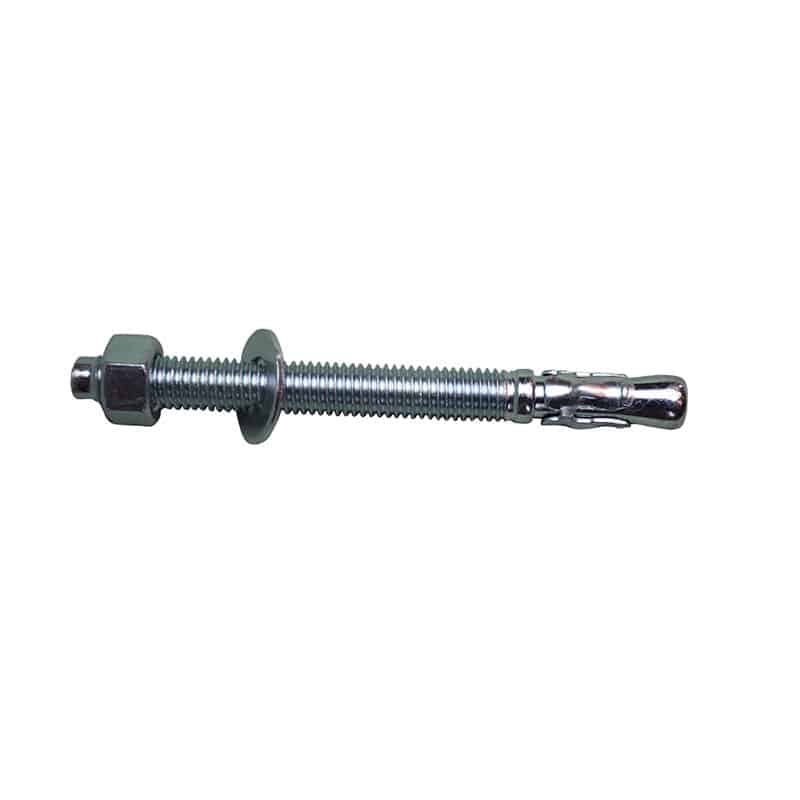
Also referred to as wedge anchors, contractors drill into the concrete and insert this anchor to fasten the building very securely to the concrete pad.
Probably The most commonly used anchor.
Mobile Home Anchor
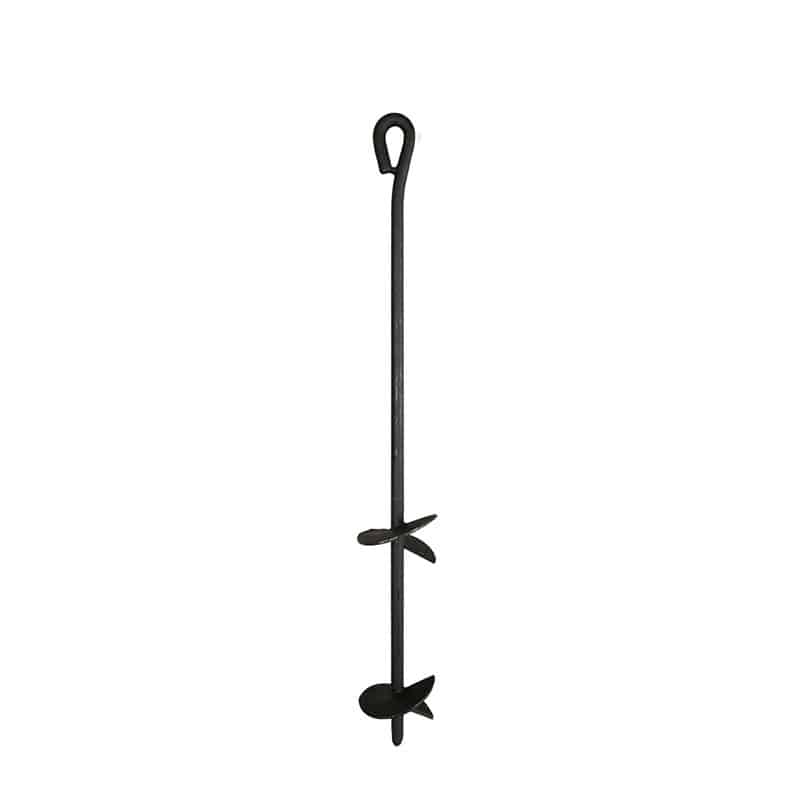
Mobile home anchors are used for securing the building in-ground installations only and are double helical in design. They are used primarily on certified buildings. Mobile home anchors can be installed as an additional security feature (not included in some buildings).
How do you Stop a Metal Carport from Swaying?
You should anchor your carport to the concrete slab, as it provides the best defense against swaying. There aren’t winds strong enough to lift a slab of concrete off the ground. Make sure the slab is installed with anchors buried deep so the vertical supports can be attached to it.
Shield Your Belongings From The Sun
Besides your home itself, your vehicles are probably one of your largest investments. Unless your home is blessed with a built-in garage, you need someplace to shelter your ride(s) from the elements such as sunlight. Throughout the course of the summer season, the sunlight can increase the temperature inside your vehicle to be unbearable. This same sunlight over time will damage the coloration of the paint on your vehicle unless protected by a carport or garage.
Prevents Pest and Infestation
- Termites cause more damage to structures than fire, floods, and storms combined. Of particular concern is the Formosan termite, one of the most destructive termite species in the world. Originally limited to Hawaii, it is now well established throughout the southern United States around the Gulf Coast and spreading rapidly.
- Steel framing is not vulnerable to termites since it is inorganic and does not provide a food source for them.
- Cold-formed steel is one of the recognized methods for compliance with the termite-resistant construction requirements of the International Residential Code.
- There is no need for annual termite treatments with steel.
- Cold-formed steel provides a healthy building with no off-gassing from chemical termite treatments or pressure-treated lumber.
- Termite damage is rarely covered by insurance. Building with steel allows owners to avoid costly problems later.
Do You Need Protection From Intruders
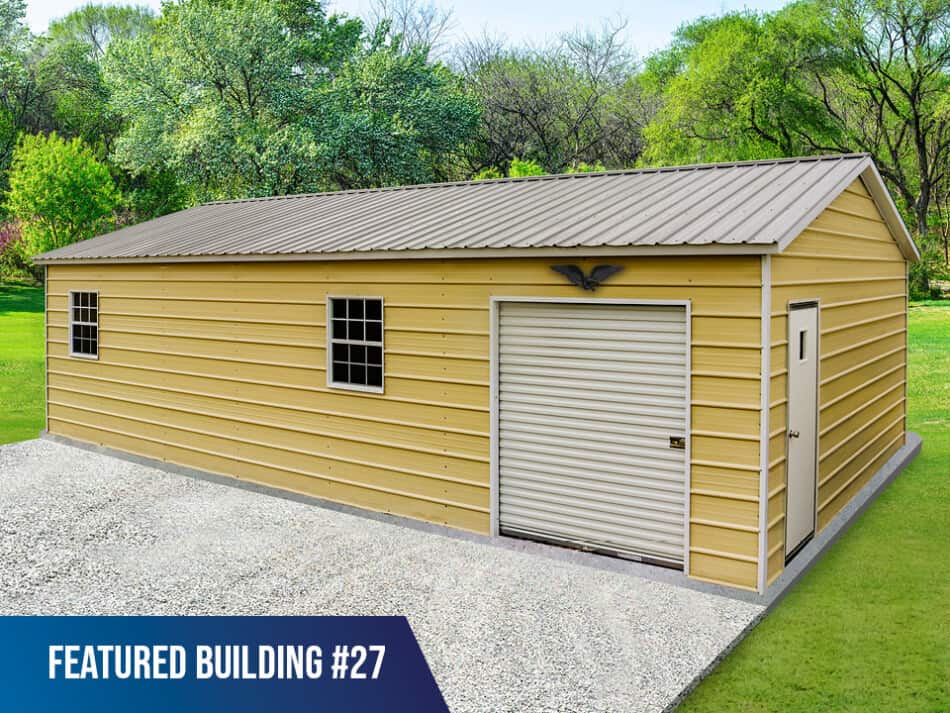
The carport is typically an open area, and consequently difficult to secure against intrusion. Instead, you can enclose the carport hence, converting it to a garage. Alternately you can install a home security system with motion detectors and floodlights to ensure that any unwelcome visitor is at least made visible to neighbors and passing cars.
What Else Can I Do to Improve the Structural Integrity Once it’s Built?
Actually, you want to make sure you take care of these details prior to building a metal carport. U-shaped channels are designed to help distribute the load on the roof equally throughout the structure, thus preventing any
structural issues during inclement weather. The type of bracing utilized on your structure will be determined by your geographical
location, the IBC code in that location, and our engineer.
PEAK BRACES
Sometimes referred to as Center braces or U braces, these are installed at the center bend of the bow on structures to reinforce
the roofing members.
Who do I trust for qualified guidance when designing my carport?
Figuring out who to trust and where to purchase a certified carport really comes down to common sense. First, look for dealers who can answer your questions and provide you with the customer service you require. Next, confirm that they have access to structurally superior, sound metal buildings.
Also, consider if you live somewhere that’s prone to seasonal hurricanes, straight-line wind storms, and other destructive wind forces. If you ignore the possibility of the damage that can be done not only to either your metal carport, garage, barn, or RV cover, then consider the items you have stored inside them. A building designed by a licensed engineer to meet a specific wind load in your area will be your best bet.
Final Thoughts
Figuring out if your carport or metal building is safe can be challenging and work-intensive, the results are definitely worth it.
So hopefully, this article has given you a little bit of knowledge about the basics of carports and metal buildings and if they are safe enough for your needs. I also hope it has increased your awareness of what is a safe carport and how you might go about buying one.
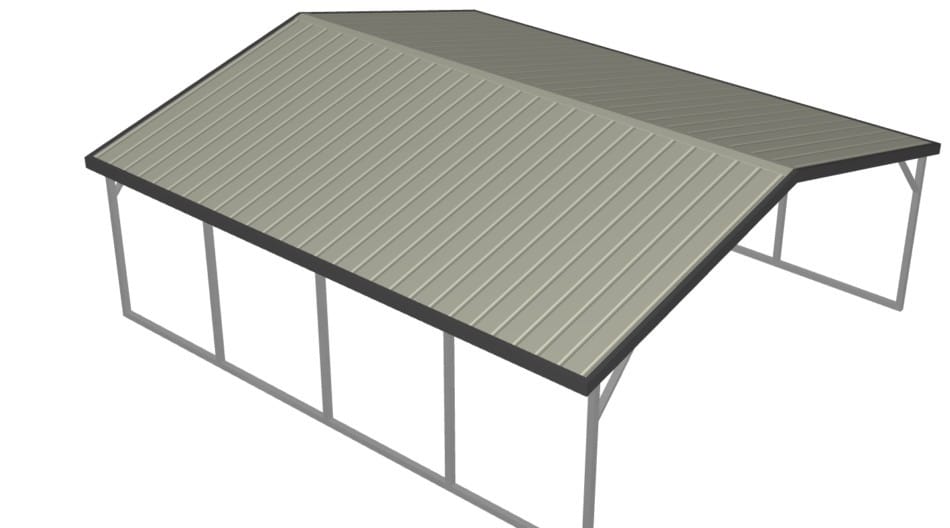
When purchasing, make sure to ask a lot of questions and get professional advice where needed. Make sure to do your research before you buy. Metal and steel construction offers protection/safety against bad weather and other elements but it’s still important to look at building design. Whichever carport is right for you, whichever design, use this post as a resource and guide.
Homeowners, businesses and municipalities looking for a cost-effective way to create a custom building that will stand the test of time are finding metal buildings meet all of their needs.
From their ability to be customized to their low-cost construction and long-term durability, metal buildings are a safe construction alternative that offers unrivaled protection decade after decade.
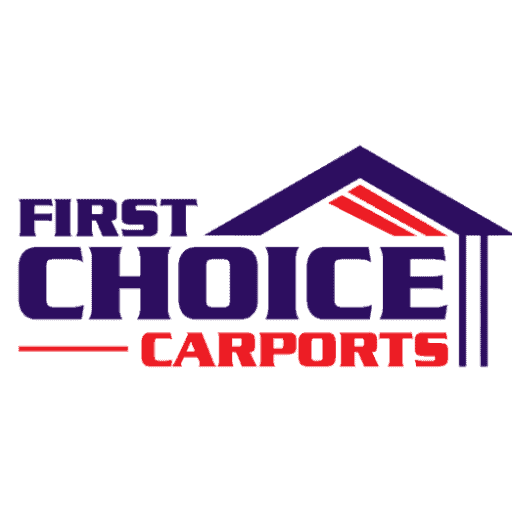
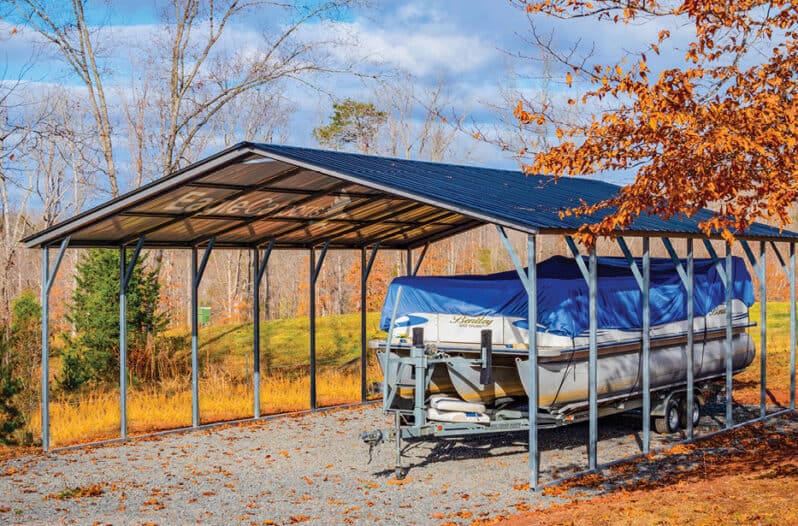

Recent Comments